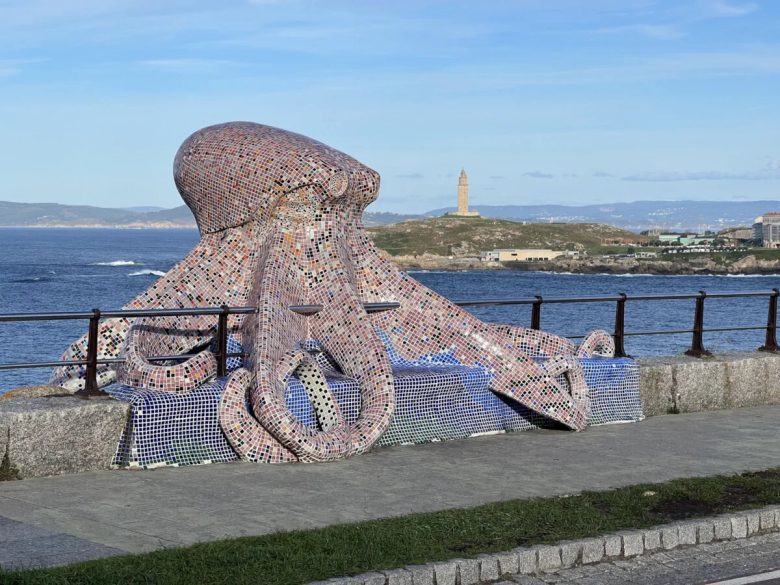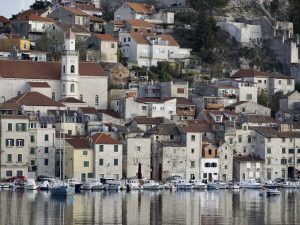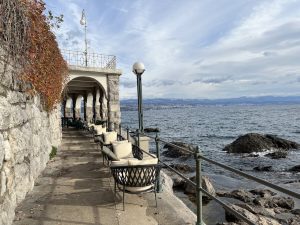O Grove, Cambados, Vigo, A Coruña, Santiago de Compostela, and Lugo
As much as we love Pontevedra, we couldn’t bear the thought of being so close to other sites in Galicia and not visiting them.
We rented a car from 9 am on a Saturday until 9 am the following Wednesday in late October. During those 96 hours, we made the most of having wheels and visited two coastal towns and four cities in Galicia.
The Galician coast is defined by four rias (estuarine bays) which create a series of peninsulas along the coast. Each ria has its own name, such as Ria Pontevedra, but the collective term for this region is Ria Baixa (pronounced like Baja in Spanish). These rias give Galicia a lot of coastline for its relatively small size, roughly in between Maryland and Massachusetts. The succession of rias (bays) along the coast creates a complementary set of peninsulas. We began our road trip with a visit to the towns of O Grove and Cambados on the peninsula just north of Pontevedra. One other “must see” village in this region is Combarro, which is known for its high density of hórreos and cruceiros, many of which are situated on the picturesque coastline. Combarro is only four miles from Pontevedra so we decided to wait on seeing it and hope to visit on foot when the weather forecast predicts 12 hours without rain. Based on recent trends, that very possibly that will never happen.
O Grove and Cambados
O Grove is a fishing town and a tourist destination. In addition to a bunch of fishing boats, the harbor had a number of excursion boats that advertised tours to the offshore islands, including the Parque Nacional marítimo-terrestre de las Islas Atlánticas de Galicia (National Maritime Park – Islands of Galicia).
Cambados is visible across the bay from O Grove but we had to drive 30 minutes around the bay to get from one to the other. Cambados felt more “touristy” than O Grove and has multiple Michelin star restaurants, so it attracts a good cross-section of visitors.
We had a nice lunch in Cambados and then walked to the Torre de San Sadurniño (Tower of Saint Sadurniño) built in the 8th or 9th century and the scene of much historical drama, including raids by the Vikings. Not much is left standing but the walk to get there is nice and includes some houses that traded in their aluminum siding for an impressive array of sea scallops shells covering the entire facade.















Castelo Sotomaior and Vigo
From Cambados, we drove to Castelo de Soutomaior (Galician spelling and no relation to the Supreme Court justice) just east of the city of Vigo. This castle was built in the 12th century and is a classic example of a feudal castle that was used effectively by the Lord of the castle to control the surrounding countryside. The castle became important in the administration of the broader region through the 1400s. In 1467-69, this region was the focal point of a peasant revolt called the Irmandiña Revolt. According to Wikipedia, this revolt was a reaction to several exacerbating factors including famine, epidemics , abuses by the Galician nobility, and political conflict (civil war in Castile ).
In the 1500-1600s, the castle became less important for local control but was still used as a strategic point of defense against Portugal. The castle fell into a state of disuse and ruin until 1869 when an heir of the estate decided to revitalize it as a summer residence. The restoration included the creation of a garden with a wide variety of tress and plants. The castle’s fortunes waxed and waned until 1982 when it was purchased by the Provincial Government and additional restoration work was done. It opened as a museum in 2018. We were not expecting much when we read about this castle but were pleasantly surprised by its state of preservation, its history, and its beautiful grounds set on the hillside overlooking the valley. The property has a posada (hotel) and a banquet hall. We visited on a Saturday afternoon and our visit coincided with a wedding reception and a Halloween themed visit by local children, which included Castle employees dressed up in costume telling what sounded like ghost stories to the group of kids. On top of all that, this was the first day we had seen the sun in over a week and the sunshine was at its peak during our visit to the castle. In the good and bad fortunes of travel, we could not have chosen better how to spend our time on that afternoon.
After the castle, we had a short drive to the city of Vigo where we found more Halloween celebrations in the city center. We visited a modern art museum there (it was nice but didn’t take any photos worth sharing) and then found something I was starting to think did not exist in Spain, which was a bad dining experience. Sometimes you have to go with the flow and when we walked into a restaurant that was packed at the end with the bar and deserted at the end with the tables set for supper, we should have known better than to ask if they were serving dinner. It was 8 pm at this point so we figured maybe we were early for the supper hour. We got a funny vibe from the host (that was warning sign #2) but they sat us at the tables and gave us menus. In hindsight, I think this bar did their big meal at lunch and didn’t really serve a supper beyond tapas served with the drinks. The interminable wait for our food and the quality of what eventually came out confirmed that the kitchen was not operating at optimal efficiency. Would have been much better if they just said ‘no’ or if we had taken the hint. In general, we try to avoid restaurants that are completely empty. We also try to avoid the one hour waits so it’s a delicate balance when you don’t know the culture all that well and you don’t know the new city at all. Lesson learned: go with the flow; follow the crowd; and be willing to walk away.















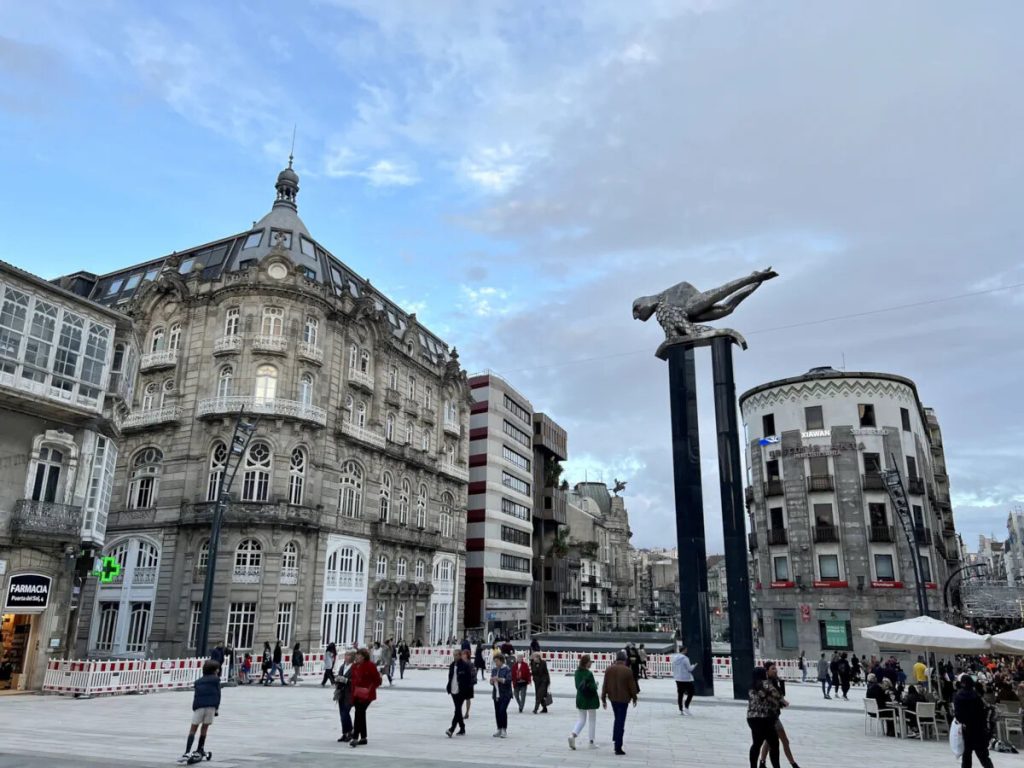



A Coruña and Fisterra
Vigo is only 30 minutes from Pontevedra so we drove back to our apartment for the night then got up the next morning and headed north to the city of A Coruña. All I knew about A Coruña before visiting was that it is one of the main bases for the Spanish Navy, specifically the Spanish Navy’s Aegis frigates. I was not prepared for how beautiful the city’s beachfront would be or how vibrant the city felt. I had been (very incorrectly) envisioning it as sort of an industrial town without a lot going on outside the port area. It helped that we had another beautiful day of weather after a week plus of rainy weather. People were out in force and the city was rippling with energy. A Coruña’s beach front faces a northwesterly direction and was getting sufficient swells from that direction for the surf to be up. We saw a surfing monument on the boardwalk so conditions for surfing must be decent more often than not.
The major site to see in A Coruña is the Torre de Hércules (Tower of Hercules) which is the oldest surviving lighthouse in the world, dating back to its construction by the Romans in the first century B.C. We walked from the beachfront to the Tower of Hercules and then visited a sculpture garden located on the same peninsula as the tower. We worked out way back to the downtown and had lunch in the Praza (Galician for Plaza) de María Pita and had a great conversation with a guy who owns a night club in A Coruña called “Mardi Gras”. He had his two dogs with him (the conversation started with me asking if they were siblings). This guy looked a bit scraggly and reminded me of Sam Elliott in Roadhouse. He also had a gravelly voice that drew you in. As we talked, he could not have been more friendly and engaging; he even invited us to his club the following week for an American Band that would be performing there. If you ever go to A Coruña, I strongly recommend checking out the night scene at Mardi Gras. You can visit the Mardi Gras website here to see what bands are coming.
We would have enjoyed staying in A Coruña longer, but we wanted to visit the Spanish version of “Land’s End” which is a peninsula called Fisterra (an abbreviation of “fin terra” or end of the world). We drove an hour and a half and arrived there just before sunset. Many people believe the Fisterra peninsula is the farthest western point of the Spanish mainland, but actually the Fisterra peninsula points south and a small peninsula 12 miles to the north called Cabo Touriñán holds that honor. For some reason, though, Fisterra is where everyone goes to see the where the land meets the sea. Probably because it’s a rugged and beautiful part of the coastline and also accessible. For those walking the El Camino to Santiago de Compostela, many pilgrims just can’t get enough walking and continue west to mile marker zero at Fisterra. To be clear, this is the “other” mile marker zero not to be confused with the cathedral at Santiago de Compostela which is the pilgrims’ primary goal.
We were all set to watch the sunset but mother nature did not cooperate very well and it was more of a fade to black due to a cloudy horizon and poor atmospherics for golden hour. It was fun being there with all the other tourists though, many of whom were pilgrims that had arrived on foot after walking the entire breadth of the Iberian peninsula. It is apparently not unheard of for hikers to leave their boots. We saw one sign that pleaded for people not to burn their boot, so that must be a thing, too. In Santiago de Compostela the next day, we saw more than one apparent pilgrim hobbling gingerly, so I can understand why some people would want to leave their boot at the edge of the world.
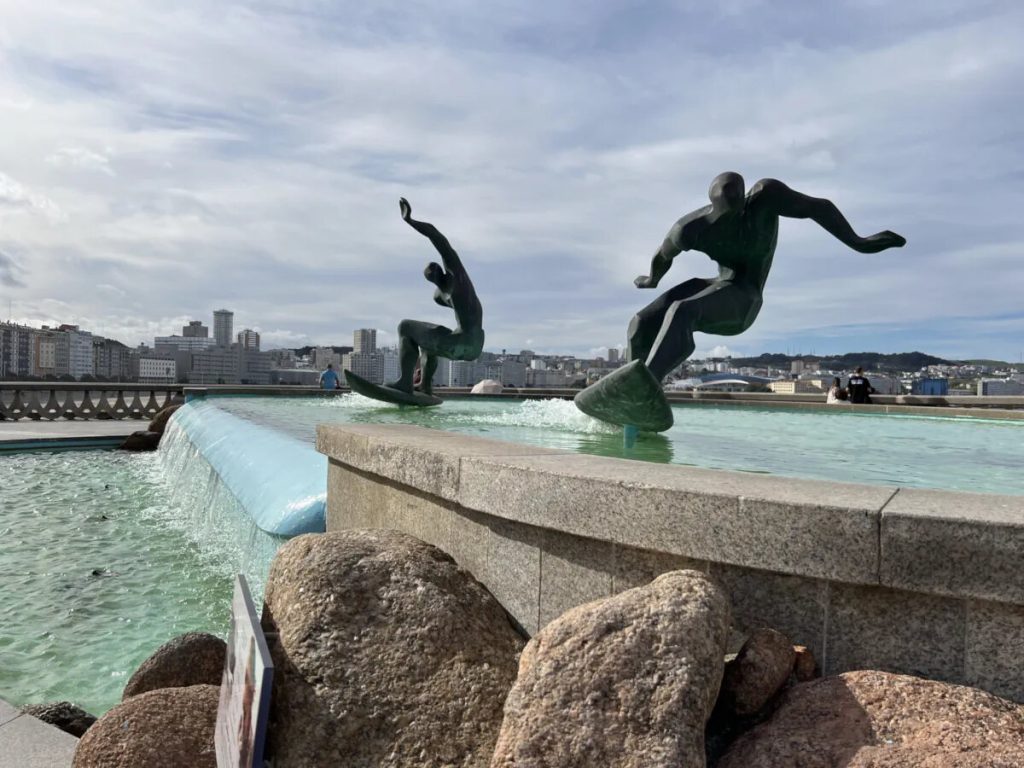







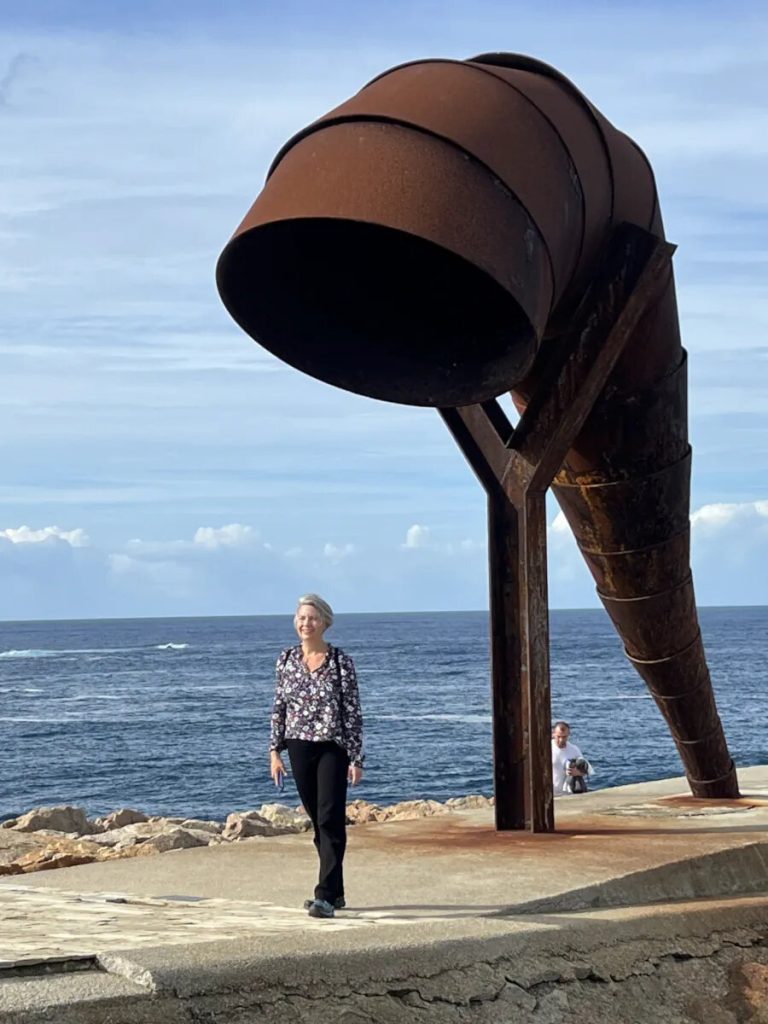
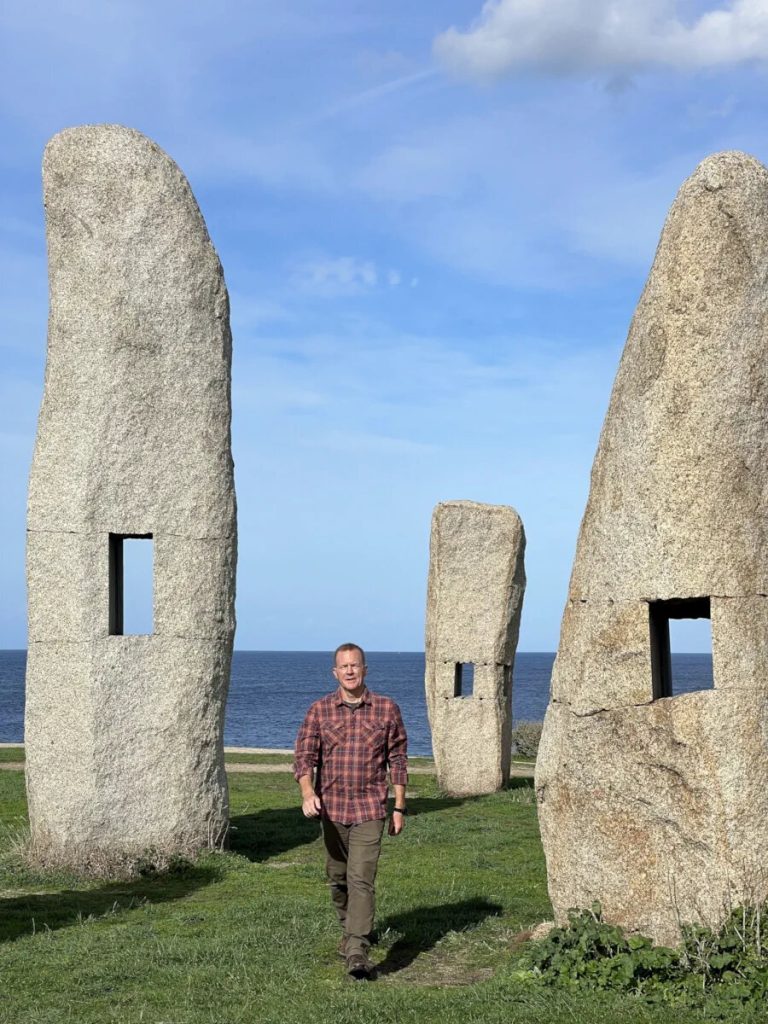
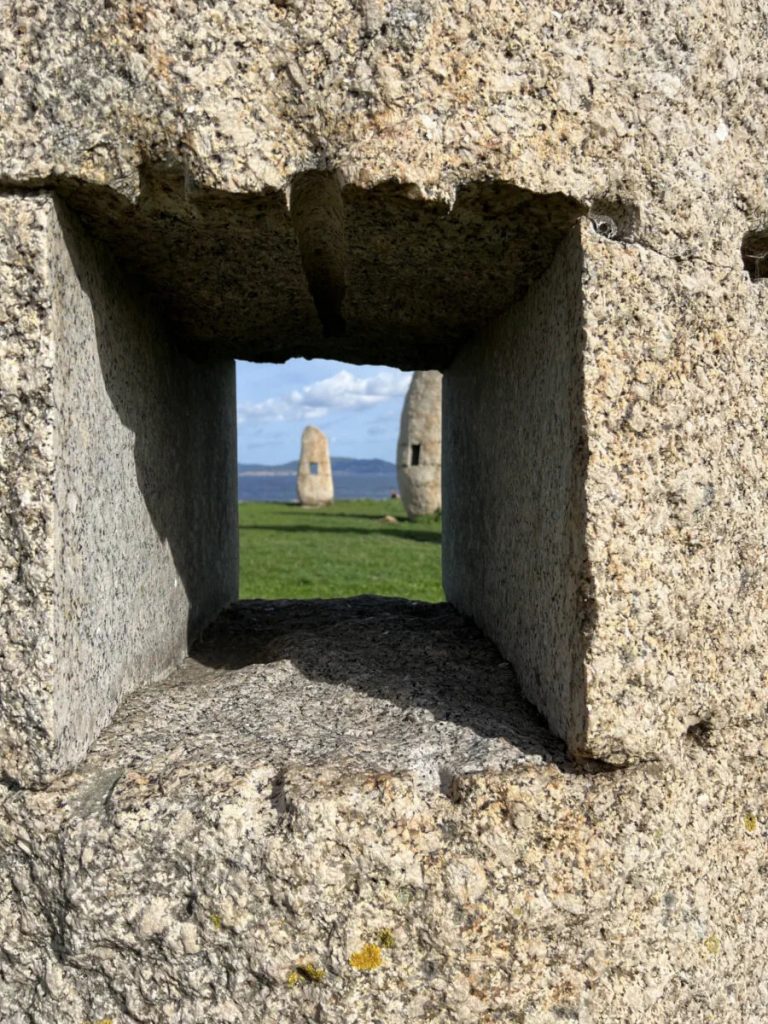













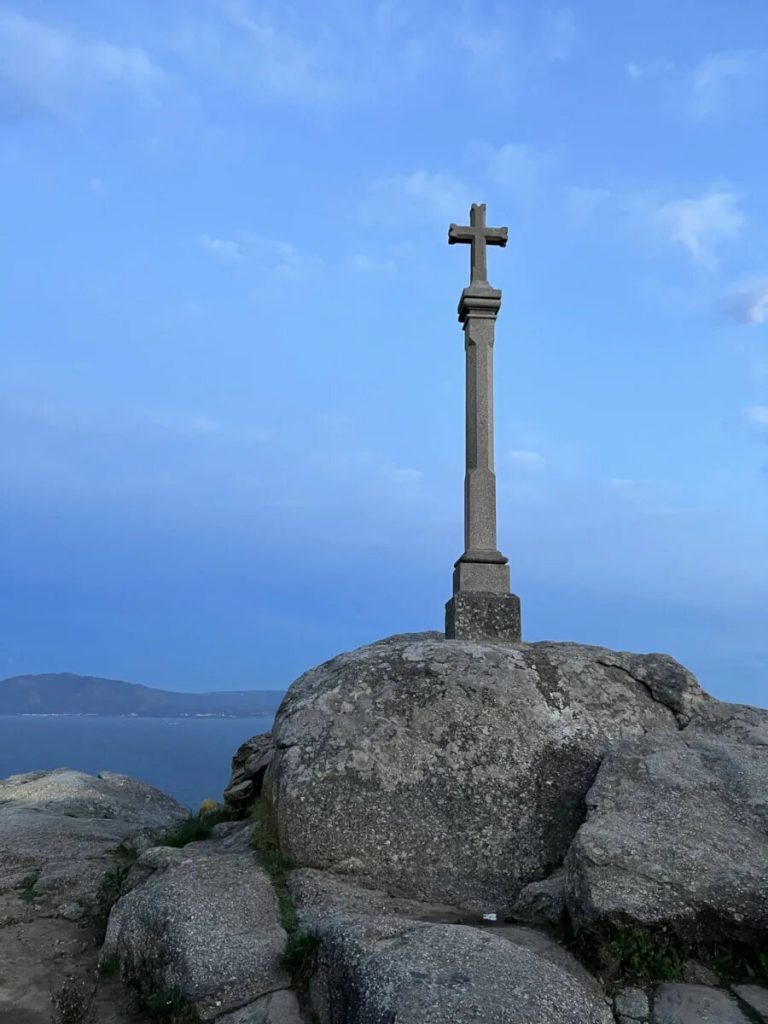

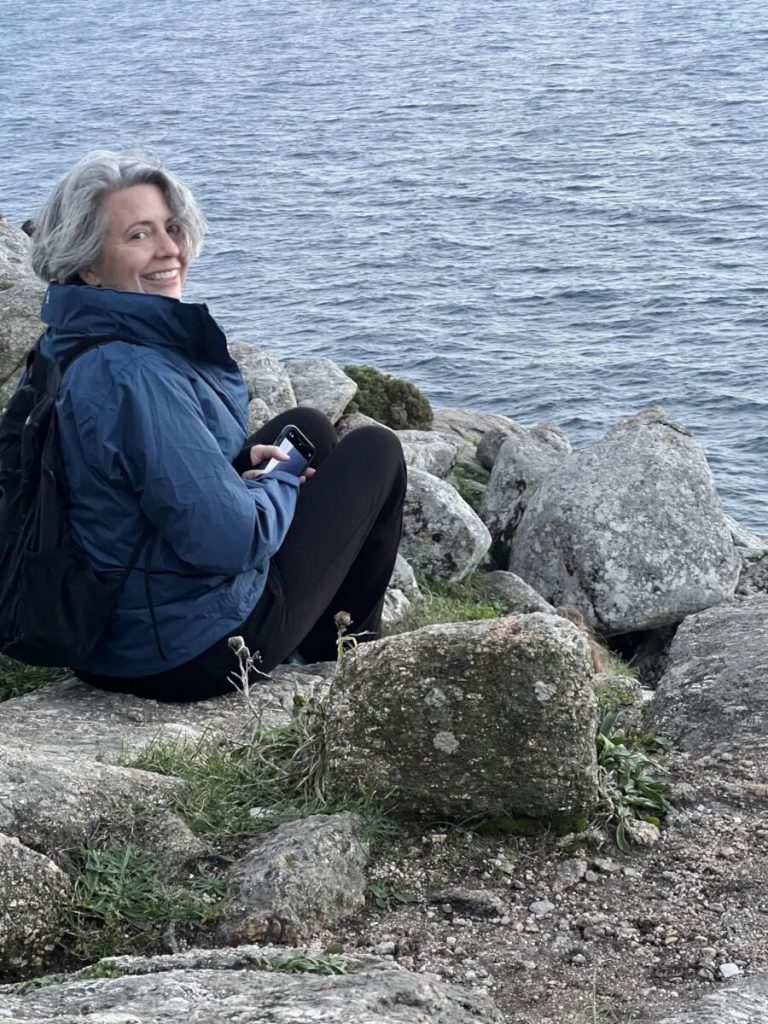

Santiago de Compostela
We drove in the twilight (and then in the dark) from Fisterra to Santiago de Compostela, found a good underground parking, and made it to Hostal Mapoula with no problem. We had a teffific meal that evening at a restaurant called Fogar do Santiso, probably the best meal we’ve had in Galicia and very reasonable considering it was on one of the main tourist (er, I meant pilgrim) thoroughfares. Among the items we ordered, I had bean soup with tripe, which is a Galician specialty and took just a little adjustment to get past the texture.
The next morning (Halloween day) we headed to do what everyone does when they come to Santiago de Compostela, which is a visit to the famous cathedral where the remains of Saint James are kept (Iago is James in Spanish; hence Santiago). St. James was not only one of the 12 Apostles, but is considered one of the “Big 3” of Jesus’ inner circle along with James’ brother John and, of course, Peter. Some scholars question whether the remains in the shrine are those of James himself. The historical record is far from clear on this question. However, the pilgrimage is a journey of faith (which is not ‘belief without proof’, but rather ‘trust without reservation’). 2,000 years is a lot of historical shrouding so I recommend each person answer this question for themselves and should probably avoid bringing up the subject at cocktail parties.
What is not a matter of faith or opinion is the majesty of the cathedral. From the first time you see it at a distance to the moment you enter, the cathedral seldom fails to inspire and impress those who make the journey to see it. To be clear, we DROVE to Santiago de Compostela (albeit in a Fiat 500) and slept very well in a NICE BED at the hostal. Even with this relatively luxurious means of travel, the cathedral blew my hair back when we saw it. Lyn did not grow up Catholic and had visited Santiago de Compostela in 1989 as a college sophomore during a semster abroad, so I won’t speak for her emotional reaction. It definitely stirred the latent Catholic soul in me though. I can only imagine what it must feel like to walk 500 miles over 35 days in all kinds of weather and then arrive to the Praza do Obradoiro in front of the cathedral. If my experience from a position of relative privilege was any kind of measure, it’s not hard to understand how fulfilling the pilgrimage must feel to the truly faithful.
To be classified as a pilgrim you have to register and walk at least the final 100 km (60 miles) of El Camino and get stamps in your “pilgrim passport” to validate your credentials. We had barely walked a kilometer from our hotel, so I felt like a bit of an imposter but I certainly was not alone. The crowd was smaller than the throngs of people we had seen at Sagrada Familia in Barcelona and much larger than our relatively private visit to the cathedral in Ourense, which possesses many of the same features as Santiago de Compostela (minus the remains of a New Testament rock star in its crypt). One big distinction from the other churches is that admission was free unless you wish to visit the museum, which is a charged admission. I suppose most people who take a month out of their lives to make this journey probably end up paying to see the museum. In our case, we needed to manage our time and opted to pass on the museum (it won’t be the last museum opportunity in Europe). So we settled with visiting the cathedral, which included standing in line for 10 minutes to get our 10 seconds looking into the shrine that contains the remains of St. James. Many people make this pilgrimage to settle some titanic issues weighing on their souls for which they are seeking relief. Considering the Fiat 500 and our nice hotel room, I decided it was best to keep my request to St. James modest.
After the cathedral, we walked around the old town some more, had lunch at a nice street side cafe, and then made our way to the city of Lugo to close out our Galician road trip.
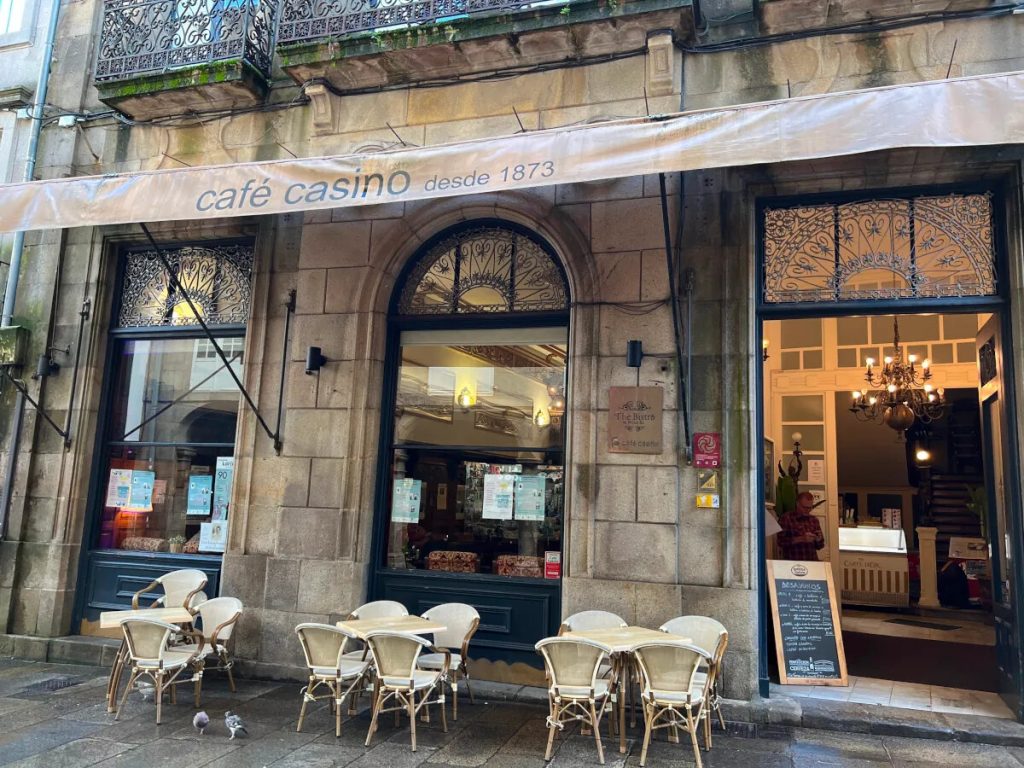



The photos below are the outside of the cathedral. While figuring out our strategy for going inside, we ended up talking to one pilgrim who was a guy in his mid-30s from the Netherlands. He told us he had done the walk in about 45 days but had stopped for a rest in the town of Potes in the Cantabria region of Spain to visit the Picos National Park. He said it was an amazing place and that we had to go there. He was waiting to meet a woman he had randomly met twice during the camino and was due to walk into the Praza de Obradoiro (main plaza in front of the cathedral) any moment. We didn’t stick around for the reunion but enjoyed hearing his story. I’m sure every pilgrim has similar experiences to share.
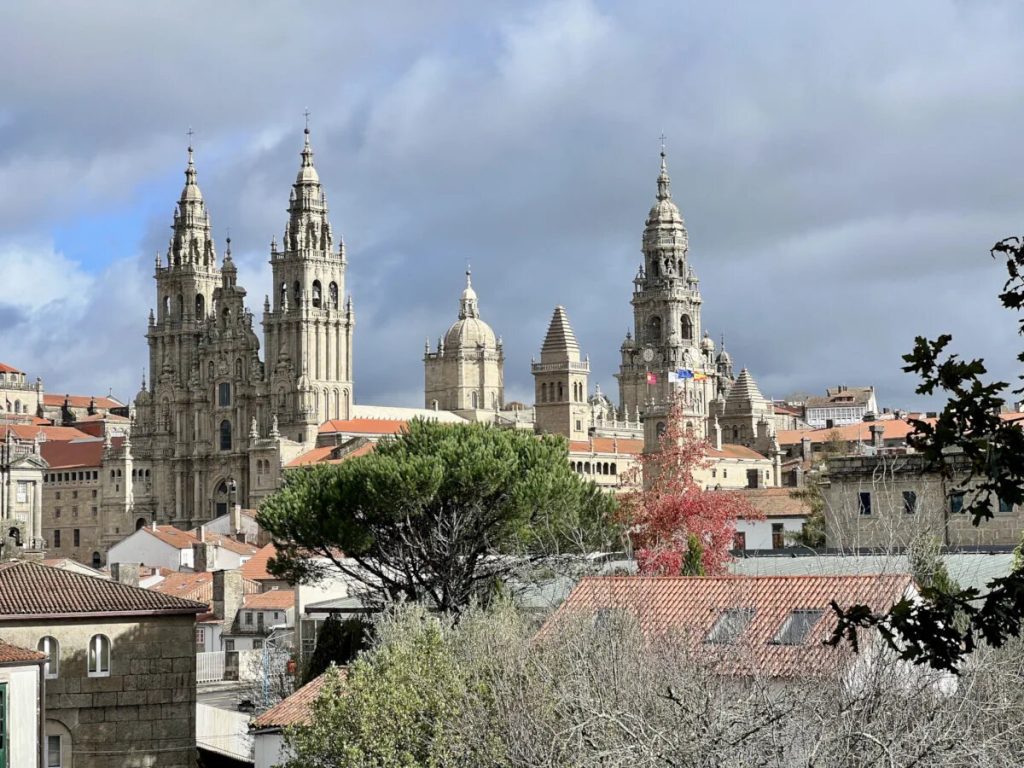
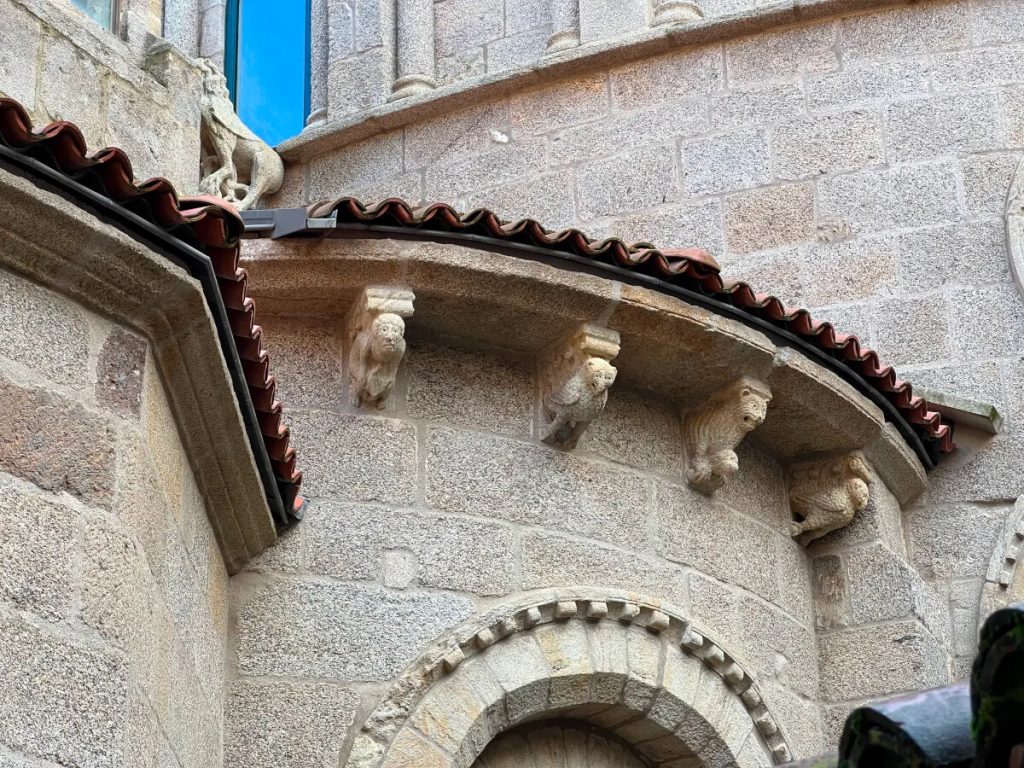




As if my guilt about arriving by car wasn’t enough, we entered the cathedral through the “Holy Door” which is a special entrance normally reserved for “Holy Years” when July 25th (the feast day of Saint James) falls on a Sunday. Due to the pandemic and the priority for public health and social distancing, the church opened the Holy Door in 2021 and it has remained open since. However, at the end of 2022, the holy door will close and not re-open until the next Holy Year in in 2027. While a pilgrimage to Santiago de Compostela is always special, it is apparently more special to visit in a Holy Year. You will see this in the pilgrimage visitation statistics over the years as well. The Holy Door in practical terms is essentially an alternate entrance to the cathedral. Its importance is entirely because of its exclusivity in non-Holy Years.
The photos below are of the inside of the church. The third photo shows the the botafumeiro (incense burner) which is an iconic element of the masses performed at Santiago de Compostela. It’s not much to see in a still shot but during mass, they swing it to distribute the incense and it’s low enough that if you are anywhere near it, the effect is apparently exhilarating and inspiring. You Tube has loads of videos showing it, none of which fully capture the emotional experience, I imagine. Here’s one video I chose at random; the swinging starts around 0:28. Sorry if you get a You Tube ad; you don’t have to click.
We didn’t see the botafumeiro in action but I wish we had because it would have accentuated the very brilliant light rays entering the church through the windows in the dome.



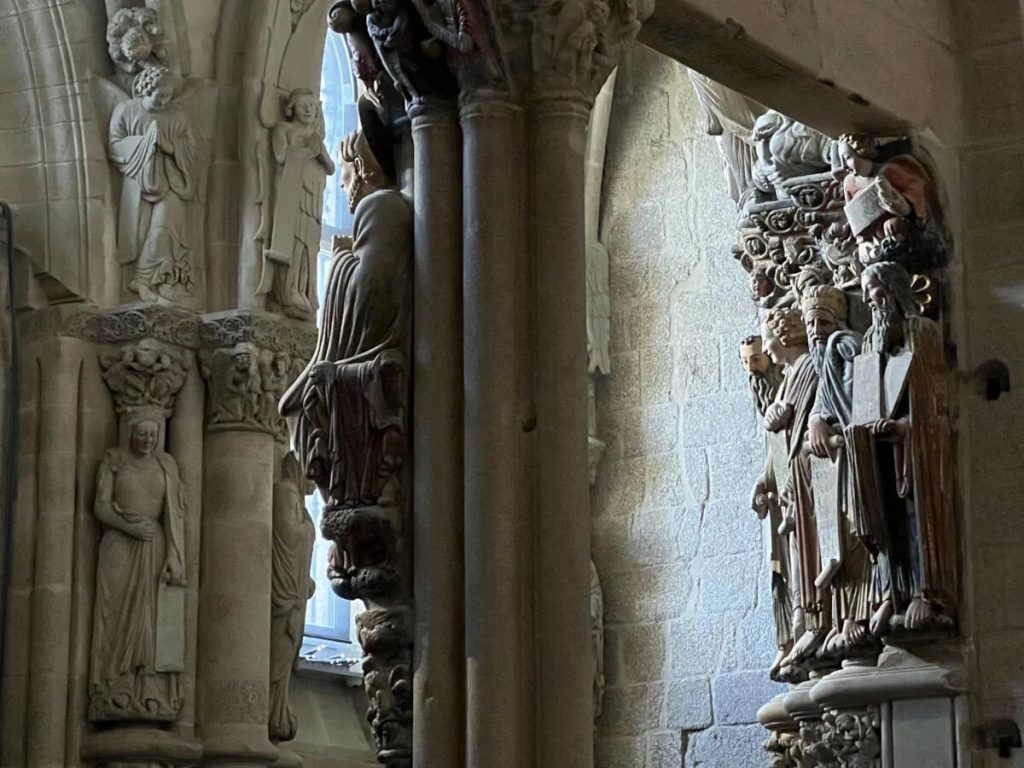
Two firsts. Before this visit, I had never seen the shrine of an Apostle and had never seen a donation kiosk in a church that accepts Apple cash. Europe, by the way, is several years ahead of the U.S. on swiping for e-commerce. I learned quickly to present my iPhone because only Americans have credit cards that are chip-only and can’t swipe. The Europeans are super sensitive about privacy and will handle credit card like it’s radioactive if you hand it to them.
This was perhaps an inappropriate rabbit hole for the solemnity of the moment but I’ve been wanting to share that observation and the e-commerce donate holy kiosk reminded me of it.


Lugo
The only thing we knew about Lugo was that it was still enclosed by an original Roman wall. As the son of Gary, that was all I needed to hear to put Lugo on our list of places we had to visit. Beyond the wall, we didn’t know much.
While we normally try to stay in the center of the historic area, we found a great last minute deal ($67/night) at the 4-star Eurostars Gran Hotel Lugo just a few blocks outside the city (not including and additional $14 for overnight parking). As a travel tip, I have found Booking.com to be a useful starting point for finding hotels or apartments. It has good filters and a casts a wide net. In some cases, we have booked our hotel through Booking.com but I usually try to go to the hotel’s website directly and see if they are offering a better price. We also prefer to make the booking directly because we still harbor some scar tissue from the early days of third party booking sites when we lived in Italy. My sense is that the information age has improved the efficiency and success rate of third party sites, but cutting out the middle man still seems to make the most sense (even if it makes me feel a bit guilty for using their site and then going direct).
While talking travel, I will also add that the cost of renting a car here is quite reasonable. We got the Fiat 500 (which you almost need to get out and push when going uphill) for $105 for four full days. We had a discount through our USAA insurance but the flat rate isn’t too much more. The rental car fee is the tip of the iceberg though. Over our four day rental, here are the ancillary costs of the car rental
Car Rental (Budget) $105
Gas (for a Fiat 500) $71 ($8/gallon; we used about 9 gallons (36 liters) total in four days)
Highway tolls $25 (we even took a no toll route on the way home to avoid the autopista)
Parking $55 (3 nights plus A Coruña. $12-14 is standard for secured overnight parking)
Grand total $256 (more than double the cost of the rental fee)
* For historical purposes, the dollar to Euro exchange rate at the time (OCT 2022) was almost exactly 1:1
Back to Lugo. We arrived just before sunset and set out to “walk the wall” encircling the old town so we could catch the golden hour. As we were finishing the 1.2 mile (2 km) loop, we saw below us a drum corps dressed in Mexican style “Dia del Muerto” costumes lining up to march into the old town. This turned out to be just the beginning of a very memorable Halloween night for us. We watched the drum corps enter the city through the gate beneath us then went down and joined the crowds of people enjoying the performance. We followed the band for a bit until they reached the Praza Maior (main square). We got a table at an outdoor cafe and enjoyed a beer and (free) snacks while the band moved on into the old town. While sipping our beers, we heard a rumbling sound from another direction that got louder and louder until eventually it came right around the corner where we were sitting. It’s a bit hard to describe but basically it was a group of “creatures” pushing a wagon that was pounding out an instrumental form of death metal on a big amplifier with a lot of bass. On top of the wagon, a demon dude was banging away on a drum set. In front of the wagon, a monster looking guy on stilts was walking around with a large staff and scaring the crap out of people. Another guy was dressed kind of like a Mongol warrior and had those creepy contact lenses in which made him look insane. As if that wasn’t enough, he was lighting fireworks and shooting flames from his mouth with liquid fire starter. Finally, the wagon itself was pushed by two “monsters” who were chained to it and they would occasionally lunge at people in the crowd. If these guys were amateurs, then they had definitely done some research on how to put together a scary scene. It was awesome. Lyn couldn’t help wanting to take pictures of it but she literally put herself behind a mother with a baby as protection from getting their attention. Some of the kids in the crowd were legitimately terrified by the experience and yet everyone seemed to recognize it was a performance and the “actors” kept a good sense of proportion. In the U.S., I’m pretty sure someone would end up getting arrested or sued if they tried doing the same thing. The fire breathing and fireworks alone would be a showstopper. It was Halloween at its best.
The other fun thing about Halloween in a Spanish city is that the kids go trick or treating not at homes but at businesses, mostly bars and restaurants. We stopped at another cafe for another beer (and more free snacks) and watched kids come and go into the bars where they patiently waited for their treats as the servers moved in and out with trays of food and drinks for customers. We had a great time watching the celebration.
The next morning we had breakfast in hotel and had plans to visit the Lugo Cathedral as well as the Casa dos Mosaicos (House of Mosaics) which is the excavated ruins of a house from Roman times located down a flight of stairs from the street level of Lugo. You can see the mosaic floor still intact as well as the forced air heating system that was used under the house. The museum definitely makes you appreciate how much dirt accumulates over the centuries and gives you an appreciation for the sturdy construction of the Roman era.
We weren’t entirely certain if either of these sites would be open because November 1st is a national holiday in Spain for All Souls Day. Fortunately, both the cathedral and the House of Mosaics were open for visitors. After the cathedral, we walked the city wall in the opposite (counter-clockwise) direction to get a different perspective on our stroll the previous evening. The wall is basically a 2 km long city park that the local residents use for running, walking their dogs, and meeting with friends. On our drive out of Lugo, we stopped to get a photo of the mighty Fiat 500 in front of the Roman wall.
First impressions of Lugo during our sunset walk on the 2 km Roman wall:



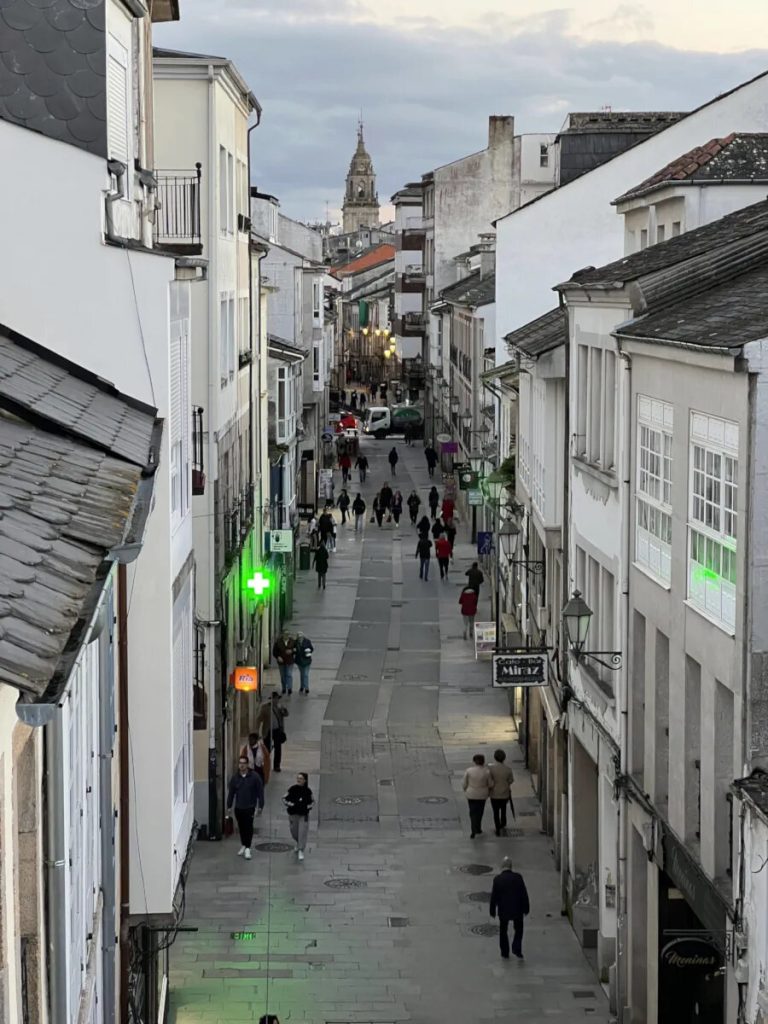


The sun goes down and the spookiness comes up!

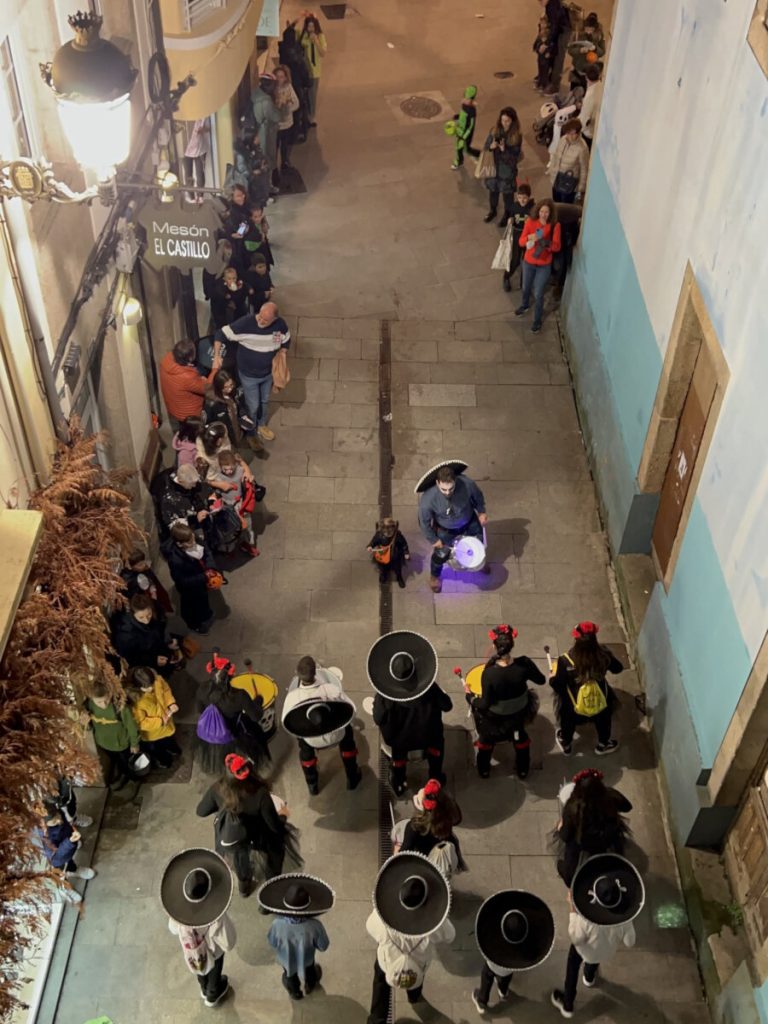





Lyn hiding behind a baby!

More Halloween fun in Vigo!


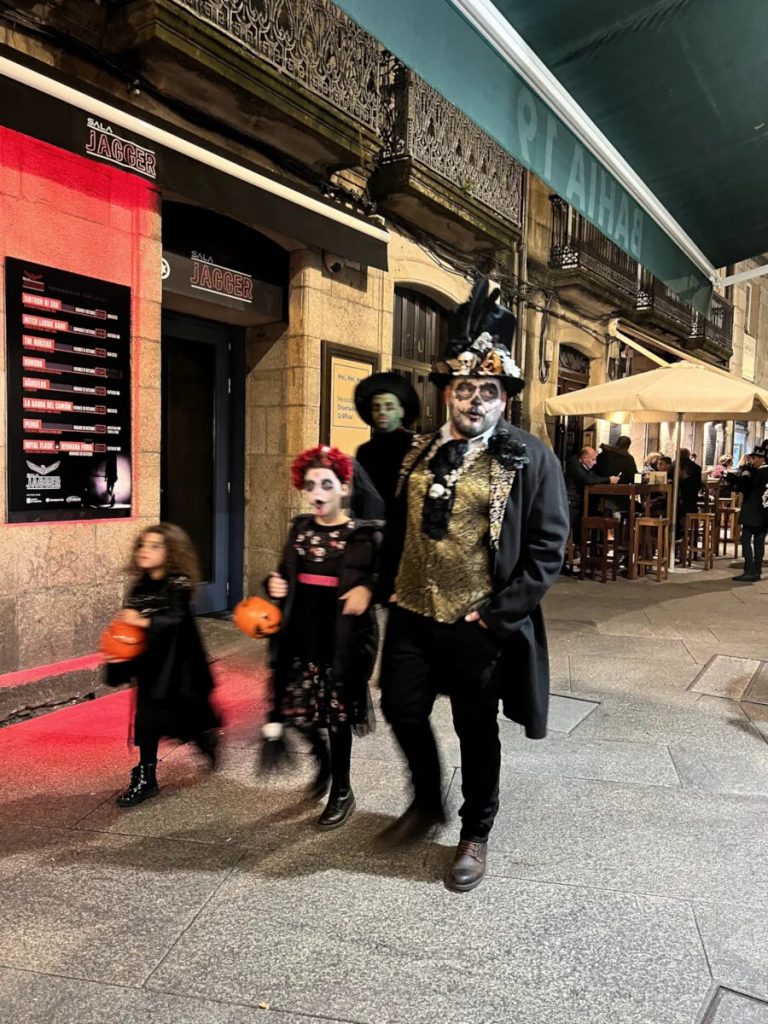
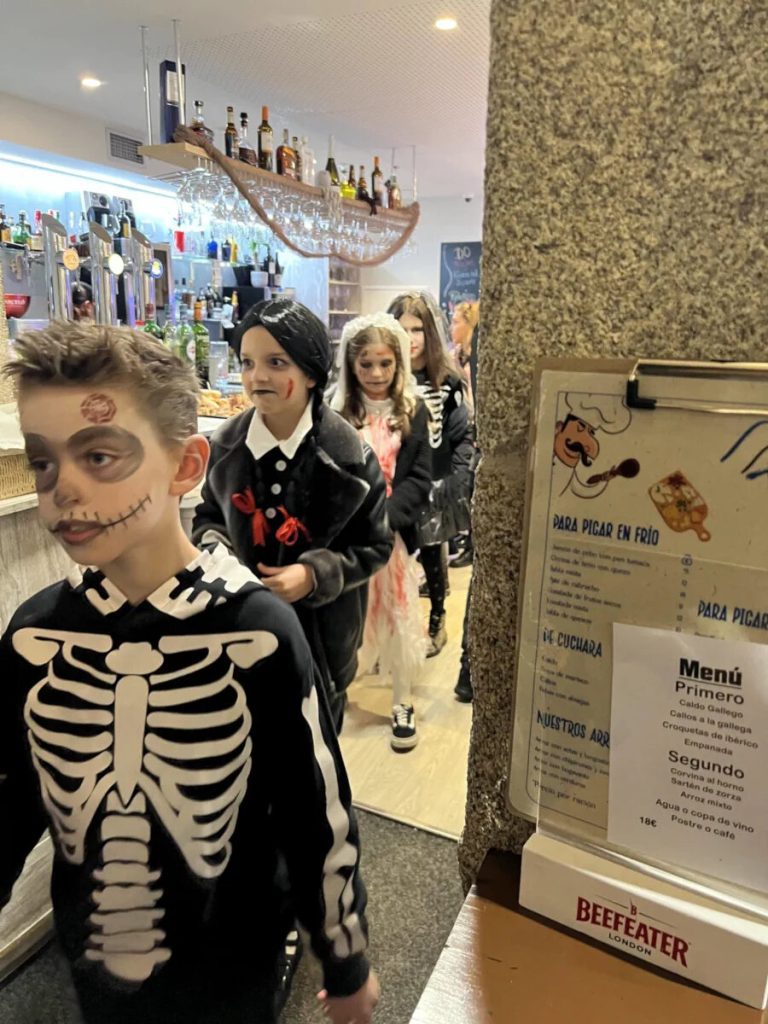



Day 2 in Lugo: Casa de Mosaics, Cathedral, and another walk on the Wall.
Some of Lugo’s old buildings have not been maintained and you see vacant lots in the middle of a block that was once all buildings. The dilapidated buildings look like rotting teeth and the vacant lots look kind of like a missing tooth in a nice smile. While walking the wall, we saw some activity down one of the streets outside the walls. A vacant lot had the remains of building timbers that were burning (smoldering really) and the fire department was on the scene dousing it.
Spain has a lot of old buildings so the challenge of maintenance is perennial. Galicia has had its economic fortunes shift back and forth over the decades so no doubt a lot of buildings are suffering from lapses in the maintenance and resourcing lapses of decades long past. It was just more apparent in Lugo than in other cities we visited. The U.S. has similar problems but on a different time scale, especially with so much wood construction as opposed to stone and brick.
Lugo’s walls are pretty dang impressive. Hats off to the Roman engineers who built them.
To be clear, though, we LOVED Lugo’s atmosphere and character. Definitely a city we would visit again just to enjoy the vibe. I also recommend coming on Halloween.







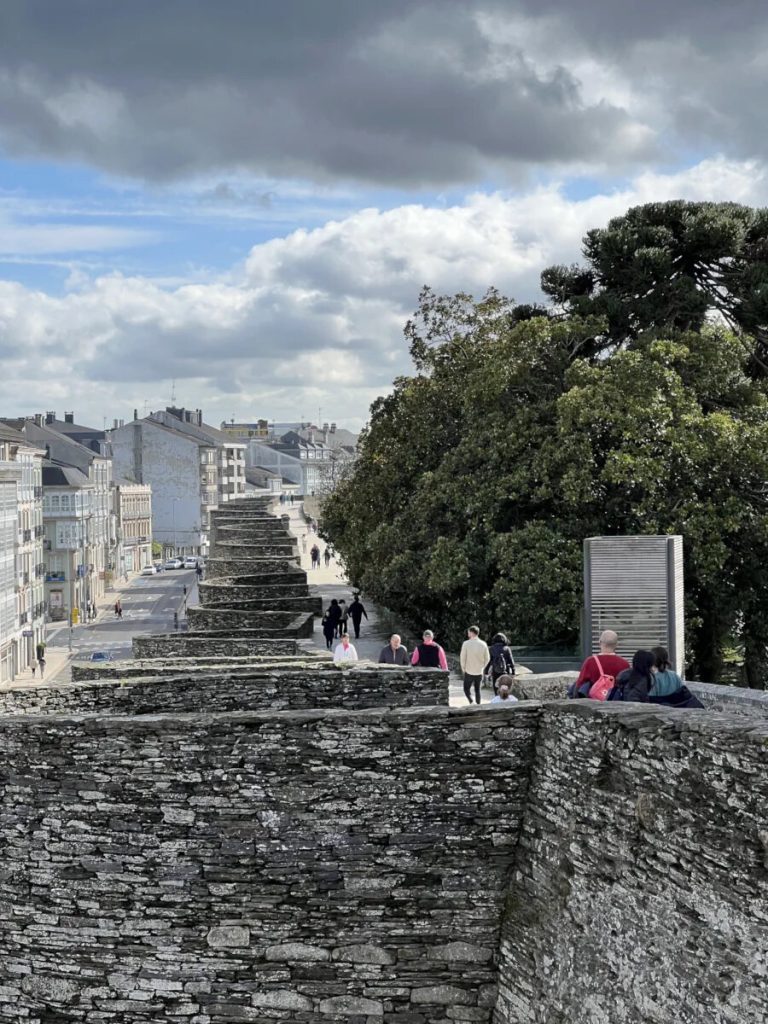





If you made it this far, congratulations. Probably could have done a post for each city. So many great sites to capture.
Our 96 hour adventure definitely covered a lot of ground and we still feel like we have barely seen Galicia. The wonderful thing about Spain is that everywhere we go, it feels both familiar and unique at the same time. These Galician towns and cities each had their highlights but they also are unmistakably Spanish in the broader patterns. We are very grateful for having several weeks in Galicia and definitely are already looking forward to visiting again in the future. I don’t think we will ever walk El Camino but a trip across the north of Spain would definitely be an experience, including a hike in the Picos.
